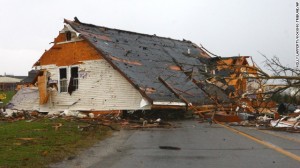When we were expanding our plant, I told the general contractor that the columns of the pre-engineered building looked too thin to hold the roof up. He assured me that the calculations had been done and done with a generous safety factor. He then went on to say that the more important question was, were they strong enough to hold the roof down? He explained that the upward forces from heavy winds can be designed for hurricanes but no building code can design for tornados where the uplift force could be greater than any downward forces the columns must support.
I thought of such considerations as I saw the devastating news about the dozens of tornados and severe storms that pummeled the Midwest on Sunday, November 17. Ironically, I was at a meeting in Chicago at the American Institute of Steel Construction when the storm hit downtown. The damaged there seemed limited to flash flooding: water actually flowed into the revolving doors at sidewalk level 30ft away from the nearest gutter on Wacker Drive and Michigan Avenue. That’s a lot of water on a very wide sidewalk.
My plant manager has a home in northwest Indiana. The sheet metal roof above his carport, made of 10 pieces of 38″ x 12ft x 18ga sheets, was torn off the supporting structure and flew 300 feet through the air to crash and dig 6 inches into the ground. He was lucky: it could have been much worse as it was in central Illinois, particularly in the town of Washington, IL.
As of November 22, experts were still trying to sort out the facts about the damage as the residents began their sixth straight day of clean up. The National Weather Service in its final survey says 24 tornadoes touched down in the state on Sunday. There were 6 fatalities and 147 people injured. As far as how powerful the different tornadoes were – most of them were an EF-2 or smaller. There were three EF-3’s and two EF-4’s.
The Pekin tornado was the first one in the state and it registered as an EF-2 causing 10 injuries. The second twister, started in East Peoria, devastated a big section of Washington and continued to Minonk, Dana and Long Point. It traveled at 65 miles an hour causing one fatality and 125 injuries.

A number of the damaged buildings had their roofs torn off, an indication perhaps of the upward forces caused by tornadoes and other heavy winds. The American Institute of Steel Construction (AISC) has developed an Architects Guide to Structural Steel which discusses some of these forces.
Gravity, wind and seismic events impose forces on all structures. Structural engineers calculate these forces and design their structures accordingly.
Engineers know that the roof structures may be subjected to net upward or suction pressures from wind. And roof shape can also affect both upward and downward forces. Curved roofs will actually exhibit a combination of pressures on the top portion of the curve and upward pressure under the roof. This distribution of upward pressures caused by the curve is similar to the principles of air pressure and lift acting on an airplane wing, thus lifting the roof off the building.
AISC and other organizations help compile the codes to ensure that buildings are as safe as possible under various conditions. The general contractor for our plant expansion hired the engineers to make the calculations that determined the selection of the steel members in our building. The columns were sized right.
With the new arrival of jumbo tubes in the steel market, engineers can design buildings using 22″ x 22″ x 1-1/4″ tubing for columns in buildings with clear spans or even in mid-rise buildings. Reports from the distributors of these jumbo tubes indicate that they are being used in “big box,” clear span buildings. Which should help hold their roofs down.







